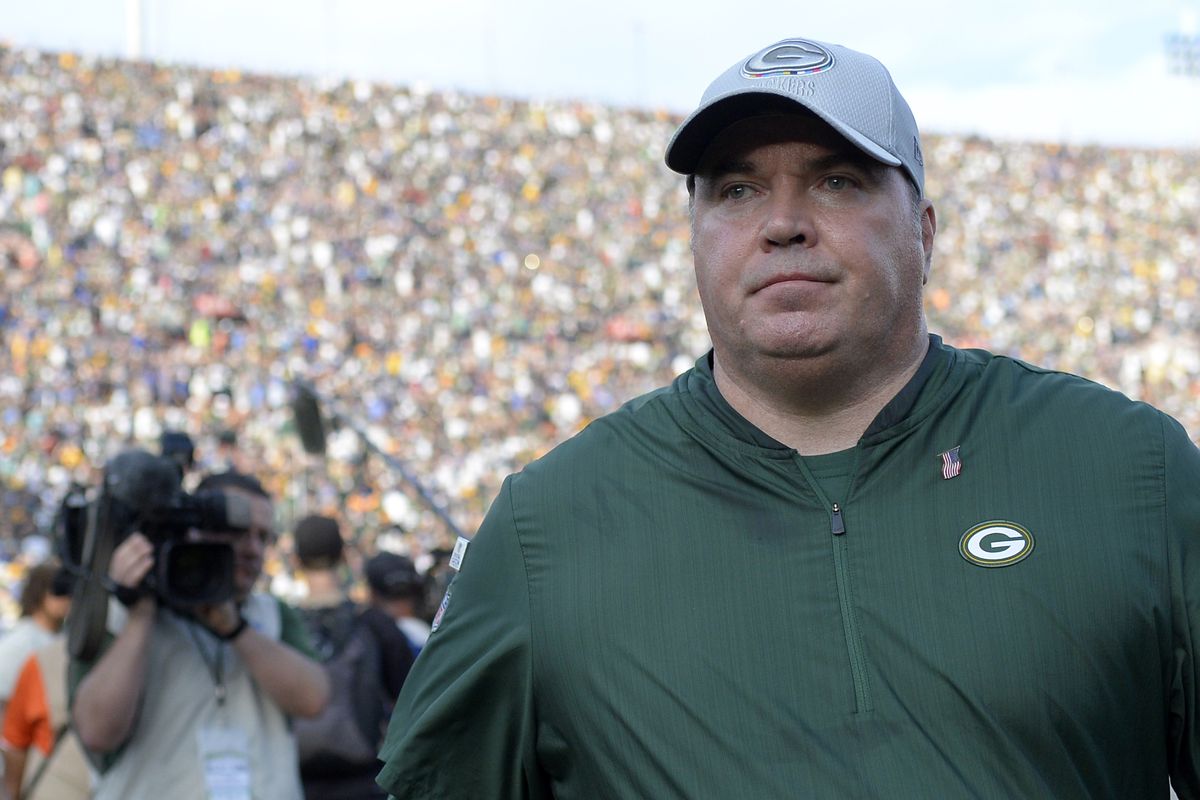All Very Similar
So having said all that, we now end up back with the passing game, and given McCarthy’s history and background, this is ultimately going to be the thing that his resume is really built around – so, this is probably the part of the Packers offense under McCarthy that is worth the most consideration. On the whole, you can see a lot of similar themes across McCarthy’s playbook, with lots of slants, curls and outs all over the place. Of course, not all of his playbook is like this, but plays like the following are the bread and butter of McCarthy’s offense:
This is an example of a simple concept working effectively, as with the near-side boundary corner bailing deep, the nickel corner is forced wide to cover the in-breaking route; with the linebacker being pulled inside by the tight end slant there is a sufficiently large window for Rodgers to fit it in to Adams in the slot. On the far side of the field, you then have a flat-slant combination to attack man coverage, meaning that you have a play that can attack both man and zone.
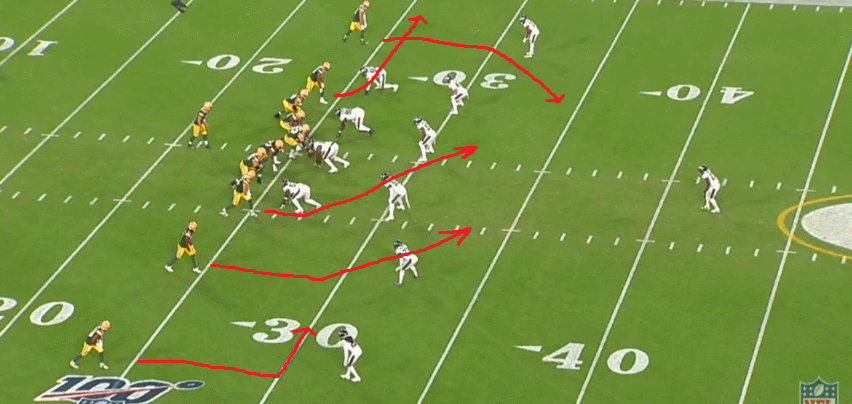
However, there are also issues with plays like this, as with no receivers going deep, the defense is able to remain relatively compact and it takes a highly accurate throw from Rodgers to get the completion. Similarly, if the Eagles do go to man, the Eagles would still have had an extra zone defender underneath and with no deep routes the windows do get very tight. However, with all that being said, this is essentially the combination of two simple concepts to create a successful completion.
The issue with McCarthy’s offense in terms of these core plays is that this homogenized depth aspect is fairly widespread, often running a series of similar routes to attack zone with one compensatory man-beating route. An easy example of this is the following play against Dallas:
The issue with plays like this is clear when you look at the route combination:
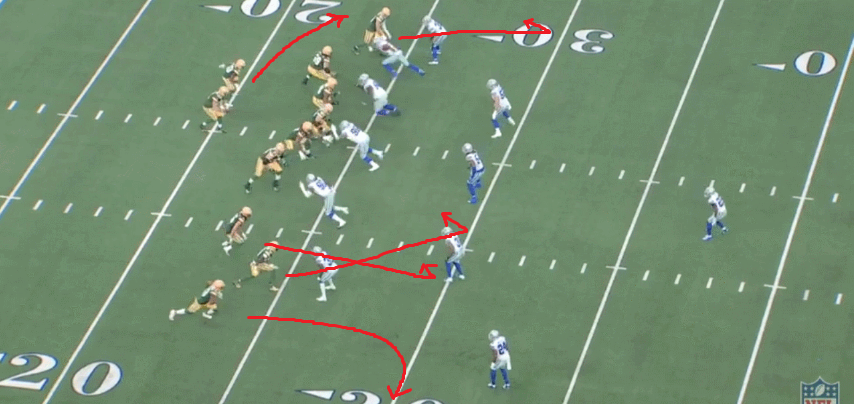
Here, you have three curls inside to attack a variety of zone coverage, with a quick-out on the near side of the field and the running back going to the flat. Against zone coverage, this play is simply a matter of finding the open man, but against man there are essentially only two options; the quick out on the near side of the field and the running back going to the flat. The first is purely a timing route which is unlikely to work with the corner playing off the line and being able to break on the route with ease and the second relies on getting a natural pick with the curl route.
In this instance, the linebacker went over the curl, allowing for the quick reception and the solid pickup. This is something that you see a lot with McCarthy, plays which essentially have one key route that the entire play is designed around – if that gets open then great, but the reason why there are so many highlights of Rodgers working the scramble drill is that there were a lot of instances where nobody got open.
Plays just like this:
Here, you have a very similar looking play to the one above:
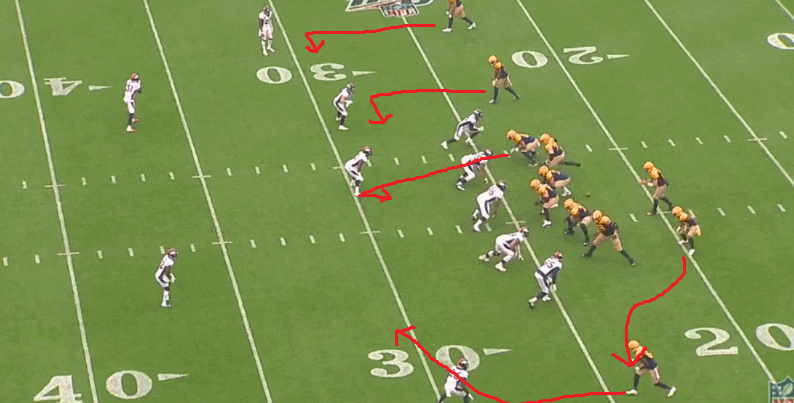
You have the double in routes on the far side and a curl over the middle to attack various zone coverages and then another flat-slant “twist” pairing on the near side to attack the blitz and drop-back man. With two deep safeties, Rodgers would likely be reading to read the near-side edge onto the near-side corner. If the edge comes down as a pass rusher then he reads the corner as to whether to go to the slant or the flat, but when the safety dives on the slant he is left without anywhere to go with the ball and has to wait for a receiver to get open outside the structure of the play.
Now, there’s nothing wrong with using curls to attack zone coverage, and the “twist” combination is a really effective way of attacking the blitz and the short middle against man, but when you end up in a situation where against man coverage, your entire plan of attack is essentially one slant, but yet where you have three different short zone-beaters, something is going wrong.
McCarthy’s playbook is filled with plays that use effective, widely-used concepts – lots of what he runs are part of the most successful offenses in the NFL, but far too much of what he ran in Green Bay did nothing to develop these concepts or combine them in new or particularly effective ways. McCarthy became the Packers’ Head Coach in 2006, and there were a number of times where that fact was all too clear on tape.
In Need Of A Hero
One of the other things that should have become clear about McCarthy’s offense at this point is how much he relies on receivers to win their individual routes.
This is something that the best defenses ultimately force all offenses into (if you play man coverage effectively, that is what everything ultimately comes back to), and when you have had the quality of receiver that the Packers have been blessed with over the past decade then this make sense. Devante Adams, Randall Cobb, Donald Driver, Greg James, James Jones and Jordy Nelson are all, or at least were, very good receivers and when you can force solo looks for these receivers on a consistent basis, you are likely to do quite well.
In fact, when you are able to get most good route runners in solo coverage, you have a chance of being successful:
This is actually one of the more interesting plays that McCarthy ran in his final full season in Green Bay:
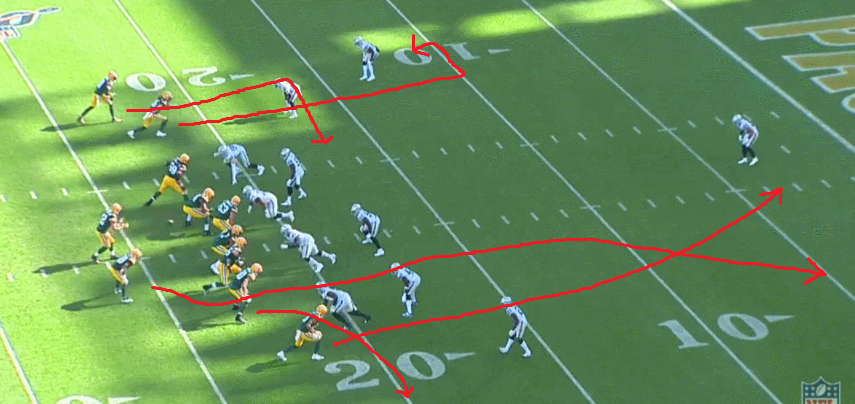
On the far side of the field, you have an in route and a deep curl that should allow you to attack most zone coverage, the tight end going to the flat force the defenses to stay close to the line while the seam route keeps the safety over the deep middle. This leaves the running back soloed against the linebacker and runs what is effectively a corner route out of the backfield. This isn’t the best-run route you’ll see – McCaffrey would likely be a far more significant threat in this regard – but whenever you have a mobile running back in solo man coverage down the field against the linebacker you have a real chance to be successful. This is a really good play design and is well executed.
The only shortcoming of plays like this is that you have to have good enough route runners to trust that they can get open in such situations – which, on the whole, the Panthers do have – as well as a quarterback who can consistently make these tight-window throws down the field – which the Panthers…..might have. If the Panthers do end up rebuilding, this is something that might not be true. It’s hard to fault McCarthy for running plays which made the most out of Rodgers’ talent, but it is also true that a lot of what he ran likely would have been far less successful if he had had a mere mortal at quarterback.
The other issue with running plays which focus quite so heavily on players winning their individual matchups, especially when combined with plays that focus a lot on the success of one route, is that this is something that teams can focus in on. Just like the Seahawks did here:
Again, this is actually quite a nice play on paper:
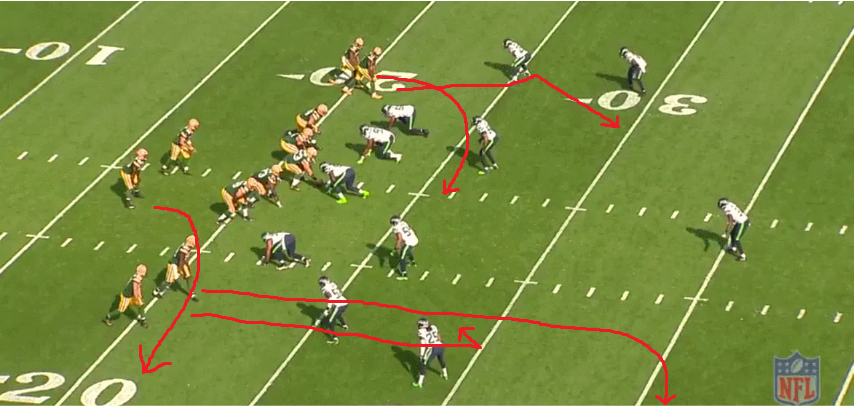
Similar to the last play, the near side of the field is designed to attack zone, with a short and deep out pairing bracketing an intermediate curl route.
The far side of the field has a drag route designed to draw the linebacker down with an intermediate in-breaking route running behind him to create a high-low read against man. On this play, the Packers are indeed faced with man coverage, and so Rodgers naturally looks to read the far side of the field. However, rather than using the two corners to cover the two receivers with the linebacker over the middle, they bracket the two receivers, with the linebacker taking the man who comes over the middle, the outside corner taking away any routes breaking outside and the other defensive back staying over the top.
It is not clear whether the near side of the field would have reacted similarly to the same route pairing, but what this meant in practice is that the Seahawks have identified Adams as the main threat, and so they have essentially looked to double him in a relatively subtle way. This is a very nice bit of defense, but given how much McCarthy’s offense relies on his top receiver consistently beating man coverage, it Is hardly a shock that a defense might look to cover Adams in this way. Of course, no play is perfect, and against more conventional man coverage this play would work, but because McCarthy runs very similar plays in very similar ways over and over again, it is much easier for teams to prepare little tricks for him in this way than for some other offenses.
Watch it again, now knowing how to beat it:
In terms of who would benefit from a McCarthy coaching hire, players like DJ Moore and Curtis Samuel are obvious choices, and while McCaffrey might be the Panthers best player on offense, given how little McCarthy’s offense is built around the run, his biggest value in this scheme might be as the primary man-beating receiver, with his ability to run routes out of the backfield making it particularly hard to double him effectively.
The person who likely would benefit least from McCarthy’s scheme is whoever ends up playing quarterback – while a player like Rodgers was able to make a success of this scheme, it’s hard to imagine that you could stick a replacement level player in and expect them to do particularly well.
Ultimately, the biggest selling point with McCarthy is the same selling point that got him the Packers job in the first place: his ability to work with and develop quarterbacks. It is hard to know how Rodgers would have turned out with another coach, but the biggest achievement that McCarthy can point to is that he was the coach who oversaw the development of the best quarterback of the decade, and probably one of just a handful with the talent to make a success out of what was frankly a fairly mediocre offensive scheme. McCarthy has done a lot in recent months to talk about how much he has learned and changed since leaving Green Bay, and this is absolutely possible and something the Panthers should have been able to probe during his interviews – reportedly, it was the reason they brought him back for a second interview; but if the Panthers are looking for an offensive mastermind, McCarthy probably isn’t the right guy.
But if they’re looking at somebody to develop a new franchise quarterback, he might have more of a case.

